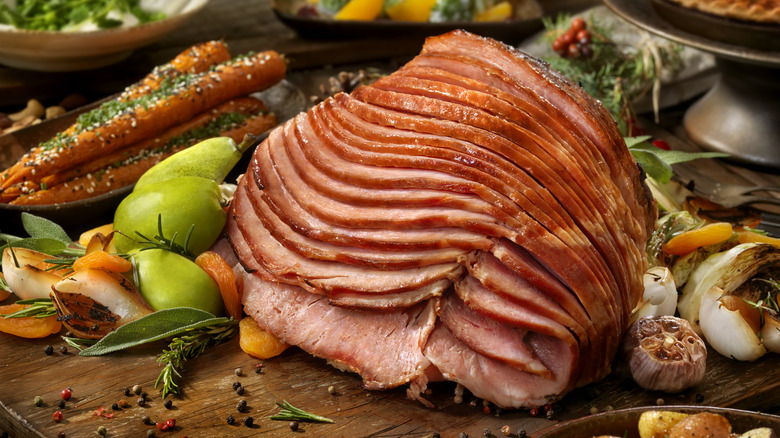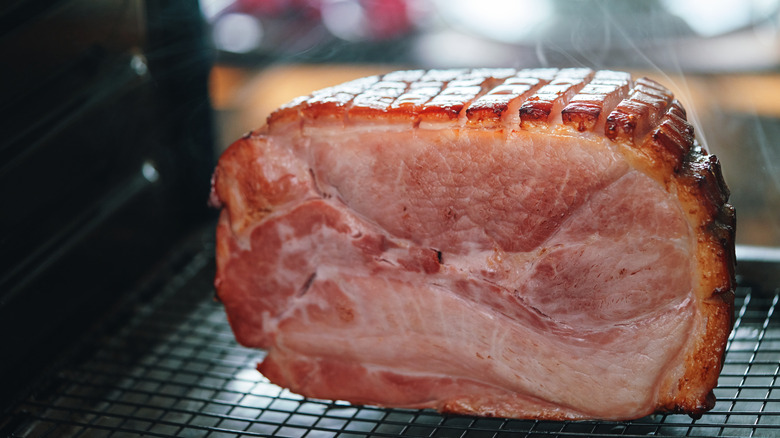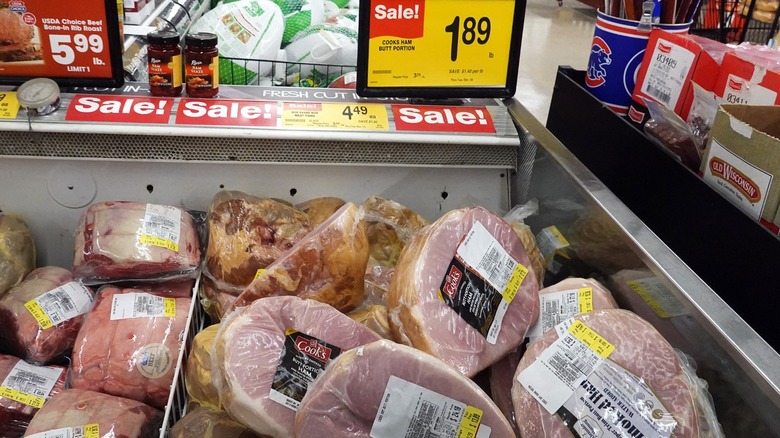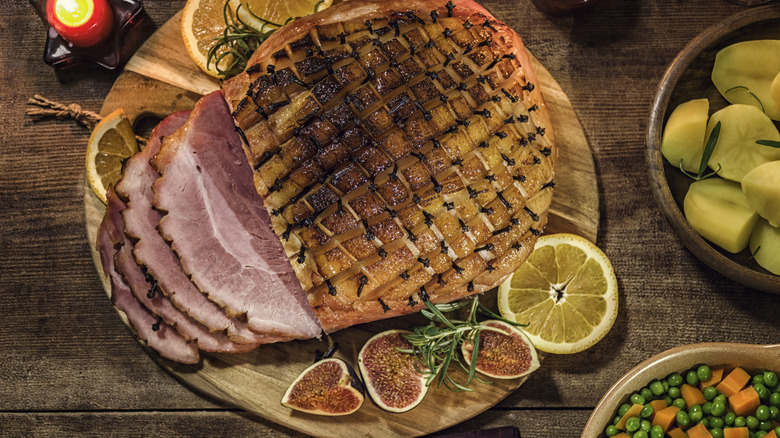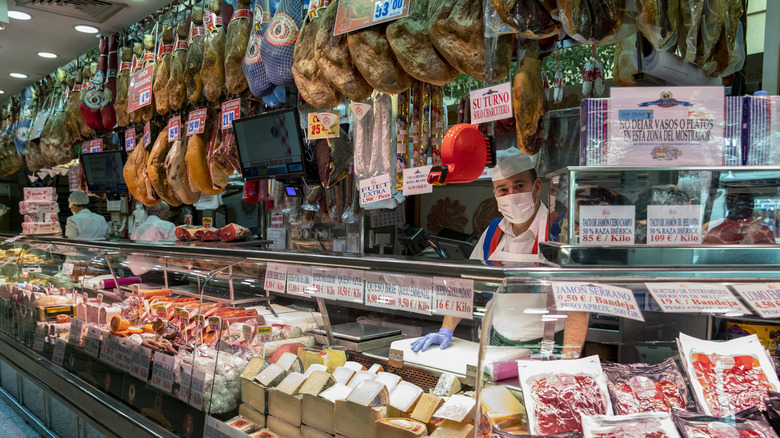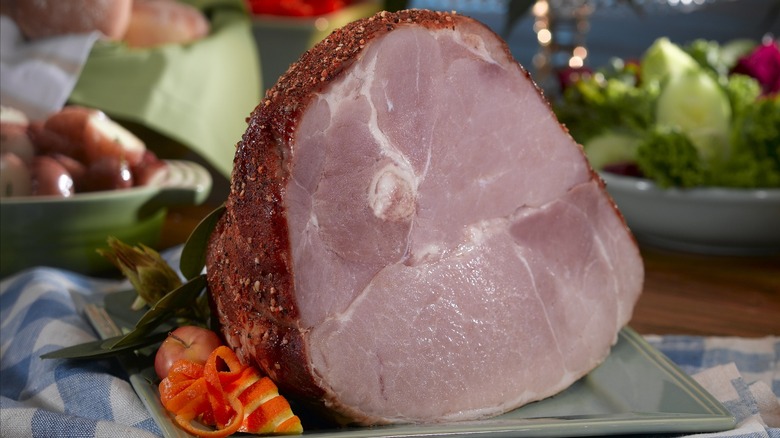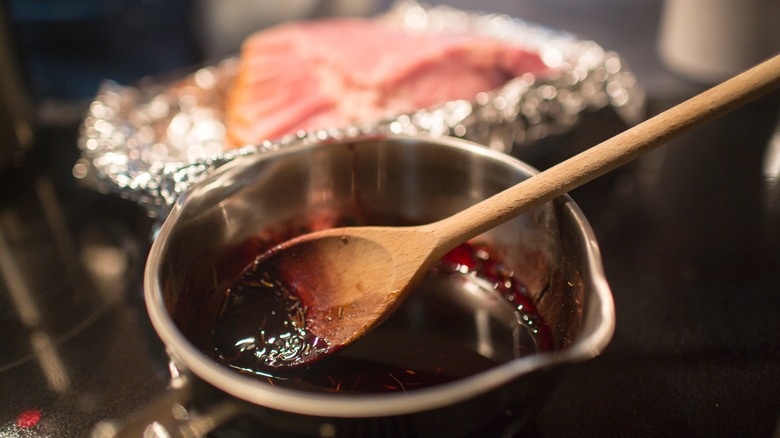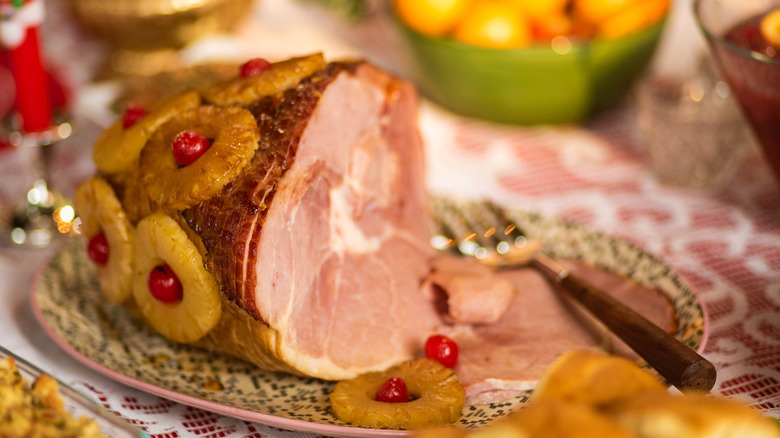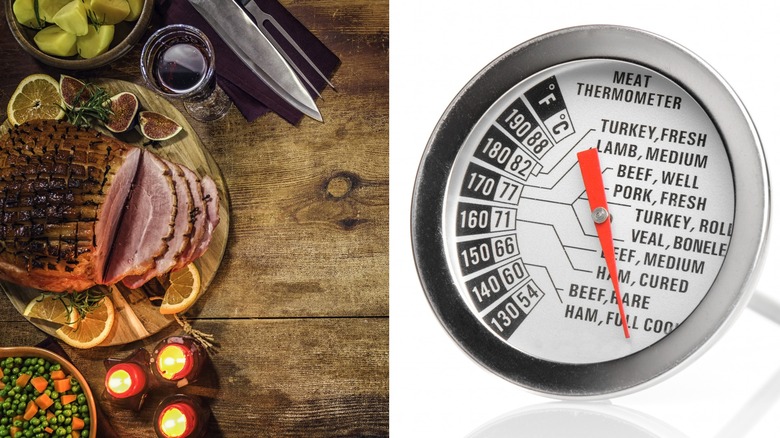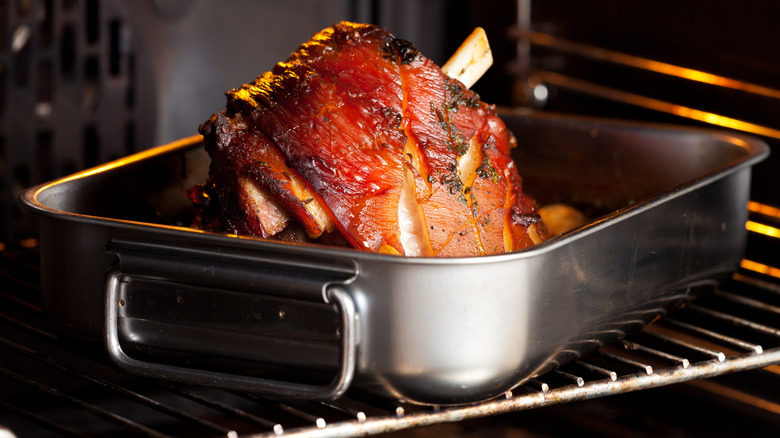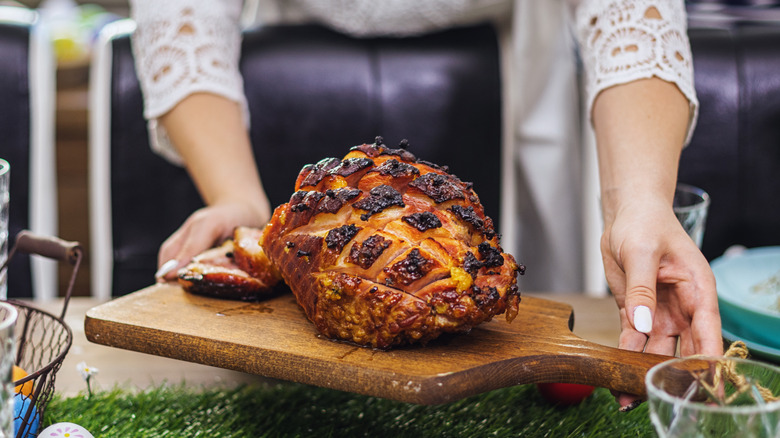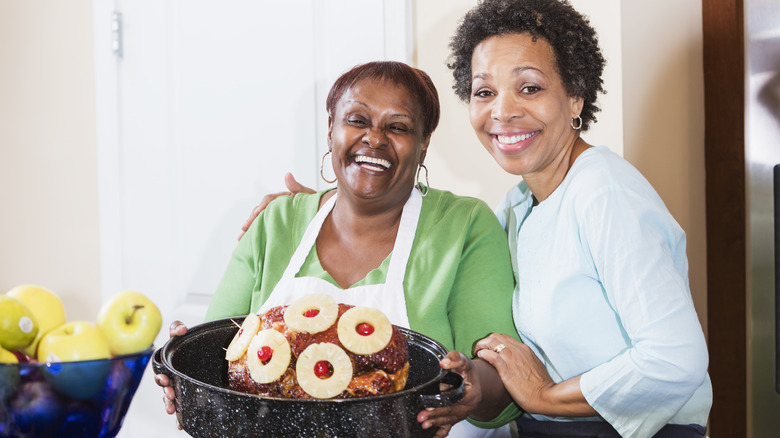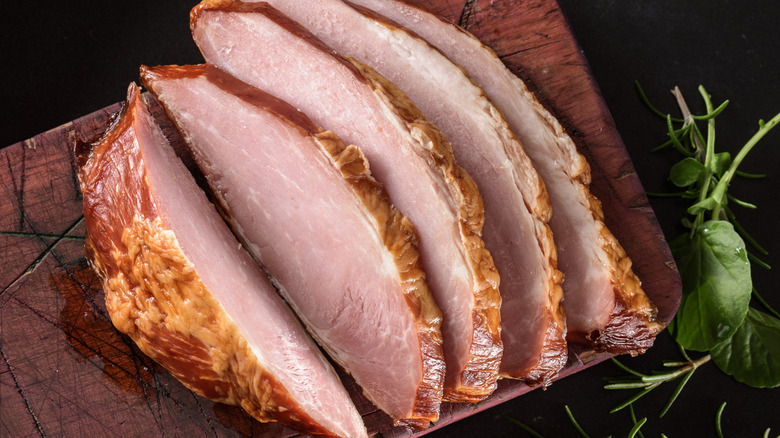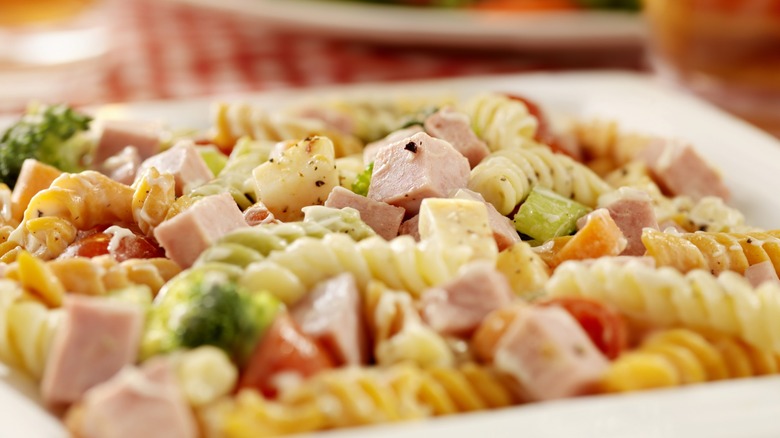13 Big Mistakes To Avoid When Cooking Ham
There's lots to love about the holiday season, like the smell of oven-roasted chestnuts, the taste of eggnog, and the feeling of a warm cup of cocoa in your hands. When it comes to major event dinners, however, you probably won't want to rely on these little extras to carry you to the finish line. A roasted meat dish is usually in order — and ham is a hands-down holiday classic.
Unfortunately, ham is not exactly the easiest dish to pull off, especially when compared to, say, all things poultry. In previous years, I have admittedly shirked my ham-making duties, opting to prepare pretty much any other dish instead (seriously, ask me about the time I tried deep-frying a turkey in my parents' driveway). This winter, I'm determined to confront my ham-related fears and tackle the challenge head-on. Due in part to my worries of destroying the centerpiece of my holiday dinner, as I inevitably did in the front yard oil spill incident of '12, I have poured hours into making sure that history doesn't repeat itself.
After studying the advice of professional cooks, celebrity chefs, and even some of the biggest names in the meat industry, I have become an expert in how not to prepare a ham. By avoiding a few key pitfalls — common or otherwise — I'm pretty confident that I can make the holiday dinner of my dreams.
1. Getting the timing wrong
It's no secret that the holiday season can be a busy time. Thanks to hectic end-of-the-year schedules, many home cooks may feel tempted to "just get the cooking over with." While preparing your ham as quickly as possible might seem like a great way to save time, it might not actually be such a fantastic idea.
According to celebrity chef, Donal Skehan (via the Irish Mirror), one of the most essential parts of making ham is knowing how much time to spend on it. In Skehan's words, speaking with RSVP live, "It all comes down to timing." If you rush through your cooking process, you might end up serving a lower-quality meal. On the other hand, if you let your ham cook for too long, you could end up making the wrong dish. As Skehan explained, "I once made Christmas ham but I ended up with pulled pork because I went out for a walk and got my timings wrong".
Although this may sound intimidating, the good news is that you don't have to make your ham on the same day that you're going to serve it. As Skehan puts it, "Ham is one of the easier things to make because you can make it in advance." In practice, this means that you can clear your schedule a day or two before your holiday meal and really put some time and effort into making your ham taste fantastic. On the day of, simply reheat and serve.
2. Forgetting to research ham varieties before going shopping
When you look at a ham, what do you see? Maybe you're a meat expert and know exactly which cut is in front of you. Or, maybe — like me — you need to read each package carefully before knowing exactly what's what. If you're in the second category and can't instantly know whether a ham is boneless, pre-sliced, or flavored, don't freak out. Most people don't cook a full ham on the weekly, so it's normal to feel a bit confused. That being said, it's essential to know that each of these options is different, and which one you want to buy.
In an interview with Eat This, Not That!, the Whole Foods vice president of meat and poultry, Theo Weening, emphasized the differences between the various types of ham. According to the meat expert, bone-in hams tend to be more flavorful, while boneless hams are easier to serve. Pre-sliced hams typically have a middle bone, making them the best of both worlds.
If you aren't sure which ham is best for you, Weening recommends asking your butcher. Let them know what kind of flavor you're hoping for and how many people you're planning to serve. This will help them find the best ham for your dinner.
3. Buying pre-brined fare
If you do opt to go to the grocery store, as opposed to the butcher, you might see something called a city ham. According to chef Alyssa Fitzgerald, this variety is not always ideal for preparing a big holiday dinner. City hams are brined in salt water before they go into the package, giving them a consistency that not everybody likes. As Fitzgerald wrote in a piece for Business Insider, "Some manufacturers will inject brine directly into the ham, which is then cooked through to get that signature pink color. This process saves time but I don't think it tastes as good."
To make sure that you buy the best quality ham possible, Fitzgerald recommends keeping an eye out for labels. "Try to avoid any labels that say 'water product' or 'water added,' since this means they've been injected with extra brine to bulk them up and water down their flavor, which can often result in an off-putting spongy texture," she wrote. Instead, opt for a package that reads "natural juices" or simply "ham" with no qualifiers. These options will oftentimes be better suited to anyone looking to keep clear of city hams.
4. Thinking that size isn't important
When it comes to choosing a holiday ham, you might think that size doesn't matter. Oftentimes, shoppers try to choose their ham based on how many people they serve and little else. While this strategy may work well for other dishes, like roast beef, it does not necessarily apply to ham. The reason? The size of your ham doesn't just impact how much meat you will serve — it can also influence the flavor of the meat itself.
According to fleischmeister and master butcher, Horst Schurger, you should try to buy a ham that's somewhere between 22 and 26 pounds. Although this might sound oddly specific, there is a method behind Schurger's thinking. As the butcher told News.com.au, hams this size come from pigs that reached the ideal age for slaughter. Those that are much smaller — or much larger — tend not to be as flavorful or rich in texture.
If you're not sure that your ham of choice actually has the deep flavor that you're looking for, Schurger recommends talking to your local butcher and even asking to taste a sample, to find a ham with a rich flavor before settling on which one to buy. Also, asking for a taste test can be a great way to open a conversation with your butcher about the kind of ham that you're looking for.
5. Buying a rotten or poorly cured ham
If knowing what type of ham to buy is important, knowing what type of ham to avoid is even more essential. Ham that has spoiled or been improperly cured could very well ruin your holiday. Eating incorrectly stored meat can lead to food poisoning, so to minimize your risk of getting sick, you might want to familiarize yourself with the signs of a ham-gone-bad before you head to the grocery store.
For Brian Schwellinger and Quinn Schwellinger, knowing the difference between a healthy ham and a rotten one is key. As the president and vice-president of Badger Ham, respectively, it's quite literally their business to know when a specimen is safe to sell. Speaking about this matter to the Green Bay Press Gazette, the pair warned against buying a ham with white or even grayish flesh. According to the Schewellinger's, this is a classic sign that a ham did not cure all the way. Even if it is safe to eat, it probably won't taste great. Instead, the Badger Ham execs suggest reaching for a ham that boasts a nice healthy pink color. These don't just have a better chance of being properly stored — they also tend to be both richer and smokier in flavor.
6. Making a glaze that's too sweet
When properly prepared, ham has a complex flavor that is neither too salty nor too sweet. As Badger Ham vice president Quinn Schwellinger told the Green Bay Press Gazette, "Ham shouldn't just taste salty ... It's a complex combination of pork, salt, sugars, spices and natural smoke. Like a great steak, it should be a sensory experience with a richness and complex combination of flavors that leaves you satisfied and not just thirsty." Hm, no pressure to perfect my recipe there! All jokes aside, however, Schwellinger has a point. A ham that's either too salty or too sweet will never release the full panorama of its flavors. But how to achieve that perfect balance?
Enter expert chef Ligia Lugo. As a professional recipe developer, Lugo has a deep understanding of how to make different flavors fuse together. When it comes to holiday hams, she is totally in favor of going for that sweet glaze — so long as you add a touch of acidity to round things out. In an interview with the Daily Star, the culinary pro explained, "A syrupy glaze will give the Christmas ham a burnished and caramelized finish ... You can use runny honey or maple syrup." She then went on to add, "Citrus juice or vinegar will add some acidity to help balance the sweetness, especially if you add sugar for additional caramelization." You can also add mustard or ginger for extra oomph.
7. Making your glaze without tropical fruits
Depending on where you live, winter recipes might include certain, pre-determined seasonal ingredients. We're talking pears, cranberries, walnuts ± all the things that are most commonly harvested that time of year in North America. While cooking with local elements can be great, there's no harm in cooking with produce that comes from other parts of the world. In fact, may professional cooks specifically search for tropical fruits in order to make the glaze for their holiday hams.
As chef Alistair Wise told Delicious, he likes to add guava paste to his glaze. He explained, "It's a remnant of when I worked with Cuban chefs, but why guava purée? In [my home town of] Hobart your reliance on the weather to give you a perfect day may well be misplaced — it's as likely to snow as be a scorcher — and the purée makes me think we're living the island life despite the meteorological Russian roulette." In a similar vein, Masterchef Australia's Matt Preston told the outlet, "I do like a ham glazed in a Jamaican-inspired combo of fresh pineapple juice, red chillies and brown sugar with a little allspice." Yum! These anecdotes show that, while buying local is always great, you don't have to for the flavors you add to your glaze. Tropical fruits can add a sweet touch to your ham, no matter where you're based.
8. Casting aside your meat thermometer
When it comes to cooking, safety always comes first. After all, who wants to dig into an undercooked ham — or deal with the food poisoning that could go along with it? One of the best ways to ensure that your holiday dinner is as properly prepared as possible is by using a food thermometer. Per the U.S. Department of Agriculture (USDA), ham is only safe to consume once it has cooked to a certain point, and the exact numbers depend on the type of ham that you've purchased. Vacuum-packaged hams must be reheated to an internal temperature of 140 degrees Fahrenheit, while fresh ones should reach 145 degrees. Leftover cooked ham should be heated even more, until it reaches 165 degrees.
The most accurate way to ensure that your ham actually reaches the recommended temperature is to invest in a food thermometer. Simply insert the metallic piece into the thickest part of the meat, and watch as the numbers slowly rise. Remember, though, that the inside of your roast will continue to go up in temperature even after you pull it out of the oven. Because of this, I like to remove my roasts from the oven a little bit before they hit that magic number, giving them the chance to hit that high point on my kitchen counter.
9. Cooking the ham at a super high temperature
Although avoiding food poisoning is important, you don't want to heat up your ham so much that it overcooks. Because of this, Theo Weening, vice president of meat and poultry at Whole Foods, says to be careful not to crank the oven up too much. As Weening told Eat This, Not That, "You don't want the temperature to be too hot or else it will dry out the meat." Instead, he suggested cooking your ham for a long time at a lower temperature, somewhere between 275 and 300 degrees. This method will allow the meat to reach the desired internal temperature, all while allowing the ham to maintain its juiciness.
While people rarely intend to serve overdone meat, accidents do happen. On the chance that you dry out your ham, don't fret — there's an easy solution for this problem. Celebrity chef Luke Mangan says that you can use your glaze to add some moisture to your overcooked meat. Chatting with News.com.au, the restauranteur explained, "If you think you've overcooked your ham, don't worry because you can just add more glaze on top once it's been carved. It will soak into the meat and moisten it."
10. Grilling your ham instead of baking it
In recent years it has become more popular to try cooking the holiday ham in non-traditional ways — like on the grill. As interesting as this might sound, some professional chefs warn against deviating from the traditional oven roast. Speaking about this topic with News.com.au, Australian celebrity chef Luke Mangan explained why he believes the oven is the best place to cook a ham: "I bake my ham in a 190C oven. I prefer that to the barbecue for a few reasons: It helps to retain the meat's juiciness and you have more control over the temperature."
In Mangan's view, these are not the only benefits of preparing your ham in the oven. Beyond allowing you more control over the meat's texture and temperature, the oven also gives you more power over its flavor. As Mangan explained, "I also think Christmas hams already have a nice smokiness to it and cooking on a barbecue might overpower its natural smoky flavor."
11. Cooking it cut-side up
When you remove your ham from the packaging, you'll probably notice that one side is flat. This is the cut-side — or the side of the ham that was cut off from a larger piece of meat. As chef Alyssa Fitzgerald noted in a piece for Business Insider, "Many people aren't purchasing an entire leg when they buy a ham, so it's likely yours has a side that's been cut down."
While this information may seem like any other fun fact, it can actually be important to your cooking process. According to Fitzgerald, throwing your ham into the oven with the cut-side facing upwards could be a major mistake, causing your meat to grow dry and chewy. To stop the meat from losing too much moisture, the chef says it's vital to make sure her holiday ham is the right way up when it goes into the oven: "When cooking, ensure that the ham stays juicy by placing it onto your cooking surface cut-side down and covering it well," Fitzgerald wrote.
12. Slicing your ham prior to dinner
Many home cooks are always on the hunt for new ways to cut down on time spent in the kitchen. Some slice their roast hams well before serving, even leaving their pre-sliced roasts in the oven to keep them toasty warm. While this may seem like a good idea, chef Joshua Smith of The New England Charcuterie says that this could be a massive mistake.
Chatting with Eat This, Not That, the culinary pro explained that slicing your meat and then sticking it in the oven is the perfect way to serve an unappetizing dried-out ham for dinner. Instead, Smith recommends carving your ham only when it's time to serve it. "Make sure the table is set and guests are proceeding to sit, then quickly slice your ham to ensure that it's nice and hot and full of flavor," he said. This will help ensure that your meat retains its juiciness.
13. Throwing away your leftovers
During the holidays, home cooks tend to dedicate hours into making the best possible eats to share with their friends and family. While this can be a rewarding process, it can also be exhausting. To prevent yourself from burning out this holiday season, you might consider making an extra bit of everything. That way, you'll have some leftovers to enjoy even in the days after your big event.
One major fan of leftovers is professional chef Catherine Fulvio. In a conversation with the Irish Examiner, Fulvio recommended saving some of your ham to repurpose as an ingredient in non-holiday dishes. "There's lots you can do with your leftovers. You can actually freeze the ham so you could dice up the ham and freeze it and use it in a pasta dish another time — a lovely creamy, parmesan-y pasta dish with that lovely Christmas ham mixed into it would be absolutely adorable," she said.
To put Fulvio's advice to the test, throw your leftover meat into this ham and Swiss cheese mac n' cheese. It's easy to assemble and quick to bake. Plus, it's an easy way to feed any hungry guests who may still be visiting in the days after your party.
